#mcad
Text
What is Idiopathic Mast Cell Activation Syndrome?
Idiopathic Mast cell activation syndrome (MCAS) is one of several mast cell disorders. MCAS occurs when there are a normal number of mast cells in a person's body but they over-release mast cell mediators causing random allergic reactions in multiple systems of the body. MCAS is incredibly common being present in an estimated 17% of the population.
Symptoms
MCAS symptoms are incredibly varied and always occur in multiple systems of the body. Anaphylaxis is common.
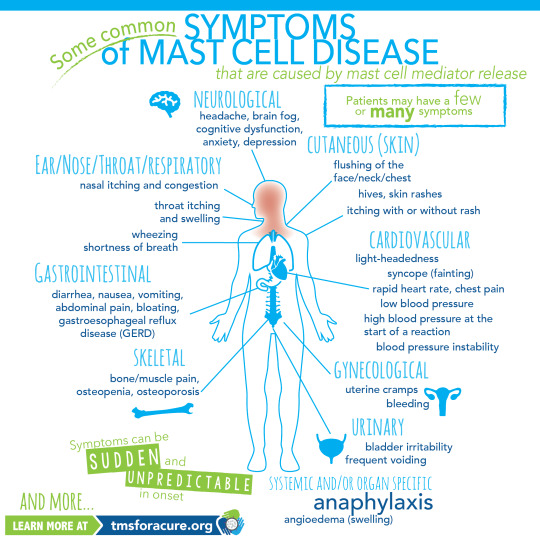
[ID: A graphic labeled "Some common symptoms of Mast Cell Disease" A graphic of a person standing in the center with multiple organs visible is shown. Around the person are lines pointing to specific areas of the body labeled with the body system and symptoms. Clockwise these read "Neurological headache, brain fog, cognitive dysfunction, anxiety, depression Cutaneous (Skin) flushing of the face/neck/chest, hives, skin rashes, itching with or without rash Cardiovascular light-heartedness, syncope (fainting), rapid heart rate, chest pain, low blood pressure, high blood pressure at the start of a reaction, blood pressure instability Gynecological uterine cramps, bleeding Urinary bladder irritability, frequent voiding Systemic and/or organ specific Anaphylaxis angioedema (swelling) Skeletal bone/muscle pain, osteopenia, osteoporosis Gastrointestinal diarrhea, nausea, vomiting, abdominal pain, bloating, gastroesophageal reflux disease (GERD) Ear/Nose/Throat/Respiratory nasal itching and congestion, throat itching and swelling, wheezing, shortness of breath and more" In the bottom left corner "Symptoms can be sudden and unpredictable in onset learn more at tmsforacure.org"]
MCAS symptoms are specifically not allergies. the reactions may look like allergies but the two are not the same and MCAS is not a condition meaning "many allergies" While MCAS can have some consistent triggers one of the defining features of the disease is that reactions are random and happen unpredictably.
Anaphylactic shock is not a requirement for diagnosis.
Diagnosis
MCAS is diagnosed by an immunologist. It is in part a diagnosis of exclusion and requires ruling out both allergies and systemic mastocytosis as well as other conditions such as certain types of tumors.
Diagnostic criteria for MCAS is debated. Some immunologists follow the symptom-based diagnosis approach in which case the diagnostic criteria are:
Recurring and severe anaphylactic-like episodes that involve more than one organ system
and
Positive response to mast cell stabilizing or mediator medications anaphylaxis-type symptoms
Others follow diagnostic criteria based on laboratory findings. In this case the diagnostic criteria are:
Episodic symptoms consistent with mast cell mediator release affecting two or more organ systems evidenced as follows:
Skin: urticaria, angioedema, flushing
Gastrointestinal: nausea, vomiting, diarrhea, abdominal cramping
Cardiovascular: hypotensive syncope or near syncope, tachycardia
Respiratory: wheezing
Naso-ocular: conjunctival injection, pruritus, nasal stuffiness
and
A decrease in the frequency or severity; or resolution of symptoms with anti-mediator therapy: H1 and H2 histamine receptor antagonists, anti-leukotriene medications (cysLT receptor blockers or 5-LO inhibitor), or mast cell stabilizers (cromolyn sodium)
and
Evidence of an elevation in a validated urinary or serum marker of mast cell activation: Documentation of elevation of the marker above the patient’s baseline during a symptomatic period on at least two occasions; or if baseline tryptase levels are persistently >15ng, documentation of elevation of the tryptase above baseline on one occasion. Total serum tryptase is recommended as the markers of choice; less specific (also from basophils) 24 hour urine histamine metabolites, or 11-beta-prostaglandin F2.
and
Primary (clonal) and secondary disorders of mast cell activation ruled out.
These are not all proposed diagnostic criteria as the subject is heavily debated. Generally, a laboratory-confirmed MCAS diagnosis is considered more legitimate.
Treatment
MCAS is a very treatable condition. Generally treatment follows a path from antihistamines -> mast cell mediators -> biologics.
Epipens are given to MCAS patients with a history of anaphylaxis.
Antihistamines are divided into 2 categories: H1 antagonists and H2 antagonists. These categories are determined based on the histamine receptor each one targets.
H1 antagonists mostly deal with systemic and cutaneous symptoms. H1 antagonists are also further divided into first and second generation antihistamines. first generation antihistamines include diphenhydramine (Benadryl) and Hydroxyzine. These tend to cause drowsiness. With second generation H1 antagonists cause fewer side effects and include drugs like loratadine (Claritin) and cetirizine (Zyrtec)
H2 antagonists primarily affect the gastrointestinal tract and include medications like famotidine (pepcid)
Typically when treating MCAS a person will be put on both a second generation H1 antagonist and an H2 antagonist.
When antihistamines do not treat symptoms well enough the next step is a mast cell mediator. The most common mast cell mediator is cromolyn sodium which is available by prescription only. (this is technically available OTC but it is at 1/50th the dose used for MCAS) Mast cell mediators work by preventing the degranulation of mast cells in the first place.
When both antihistamines and mast cell mediators are insufficient someone with MCAS might be prescribed a biologic such as Xolair to treat their remaining symptoms.
Sources:
American Academy of Allergy, Asthma, and Immunology
Mast Cell Hope
Mast Cell Activation Syndrome: Proposed Diagnostic Criteria
#mast cell activation syndrome#mcas#mast cell disease#mast cell activation disorder#mcad#chronic illness#chronically ill#physical disability#physically disabled
48 notes
·
View notes
Text
HEY YOU! WANNA SUPPORT MY TRANS BOYFRIEND IN CONTINUING HIS COLLEGE EDUCATION?
https://gofund.me/d2c1a55
any little bit counts!
you can also support him by commissioning him!
@goblinkingvinny is his username pretty much everywhere!
#art#artists on tumblr#my artwork#digital art#t4t#queer#trans#transgender#MCAD#chonny jash#tagging cj because half my followers followed me for the album art and i want as many people to see this as possible
37 notes
·
View notes
Text

Here's a little traditional sketchbook drawing I did of me and my partner.
#pifflz_pufflz#pifflzartdump#thekerpifflerart#myart#artistsofinstagram#artistsoninstagram#illustration#sketch#mcad#vividcolors#furry art#furry artist#cutecouples#hyena#possum#artists on tumblr#artistsontumblr#artistoftumblr#anthroart#sketchbookdrawing#sketchbook#traditional drawing#traditional sketch#traditional illustration#copicpen#inkdrawing#poscapaintmarkers
88 notes
·
View notes
Text
Everyone says they’ll be there for chronically ill people and they want to make sure we feel supported …
Until we keep not being able to do things and we never get well. And it becomes clear that this is just our daily normal.
#disability#chronic illness#chronically ill#chronic fatigue#chronic pain#ehlers danlos#pots syndrome#postural orthostatic tachycardia syndrome#MCAS#MCAD#like I get it#it isn’t easy#but it hurts so much worse#when you offer your support#and then rescind it#the moment it becomes clear#that we’re gonna struggle#like daily#and it’s never getting better
11 notes
·
View notes
Text
When they get my order wrong and I can’t eat it...

20 notes
·
View notes
Note
I seem to recall some story about Dobson that I'm sure he lied about (which one, right? lol) where he went back to MCAD for a convention or something but he claimed everyone at the school knew who he was and acted like there was some conspiracy or something against him and they "prepared" for his arrival by constantly talking about him. Then he went and kept hanging around tables run by women and made them notably uncomfortable which I think he pretty much admitted. At least he told he truth there. Do I have that right or am I confusing two different stories?
You’re remembering one particular story, you’re just a bit hazy in the details. Here you go.
7 notes
·
View notes
Text
I’ve lost track of how many ambulance rides I’ve taken.
I’ve probably given over 100 epipens by now.
My thighs are permanently bruised.
I’ve stabbed my thighs with trembling hands as my eyes are going dark, hoping the air will come back and this won’t be the final time.
I found out I get steroid psychosis, so they can no longer be part of treatment, but not until after they made me gain so much weight and I lost several days of memories.
I’m scared of every food and every scent because previous safe ones have flipped to danger.
I miss peanut butter.
Malted barley flour is in so many things.
I’m terrified that I’ll develop an allergy to Ruby.
The summer heat has closed my throat too many times.
Pictures from 5 years ago I was so genuinely happy.
This has taken over my life.
I hate this.
12 notes
·
View notes
Text
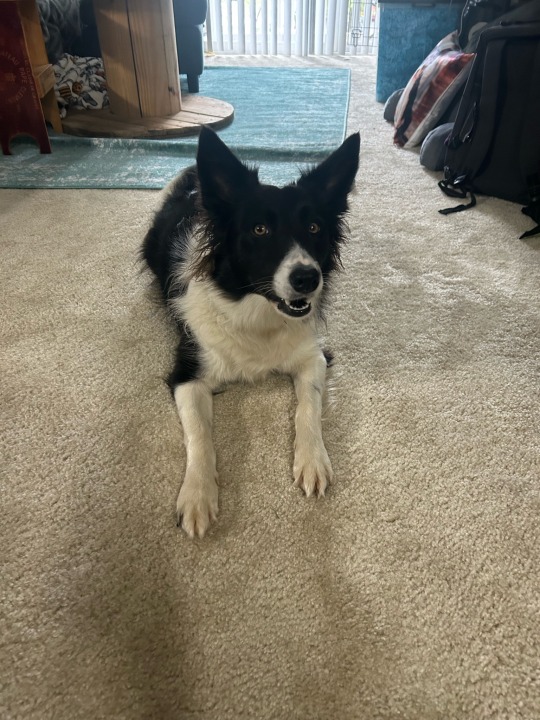
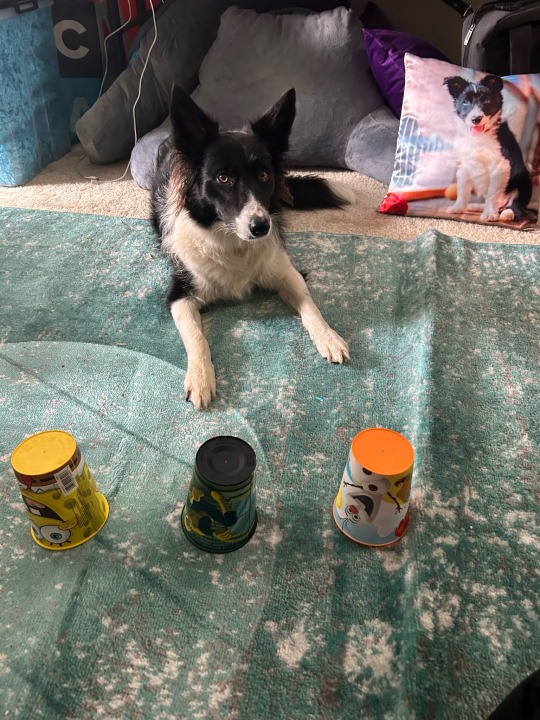
Today was one of those “I don’t want to wake up” days. And not in the “I’m tired and don’t want to go to work” way. It was in the “I’m over being constantly physically and mentally ill and don’t want to exist” way. Overall, I’m doing much better but I still have these days sometimes.
In comes Scully. The second time I snoozed my alarm, she decided that was unacceptable and I needed to get up to take her out Right Now. She decided that even though she normally eats breakfast from her bowl on weekdays, that today she needed me to interact with her for her to eat (we did the shell game with fun cups!) She was the reason I was able to get up and get coffee and start my day so I can help other doggos today at work 🙂
She has no idea how wonderful she is💜
3 notes
·
View notes
Photo
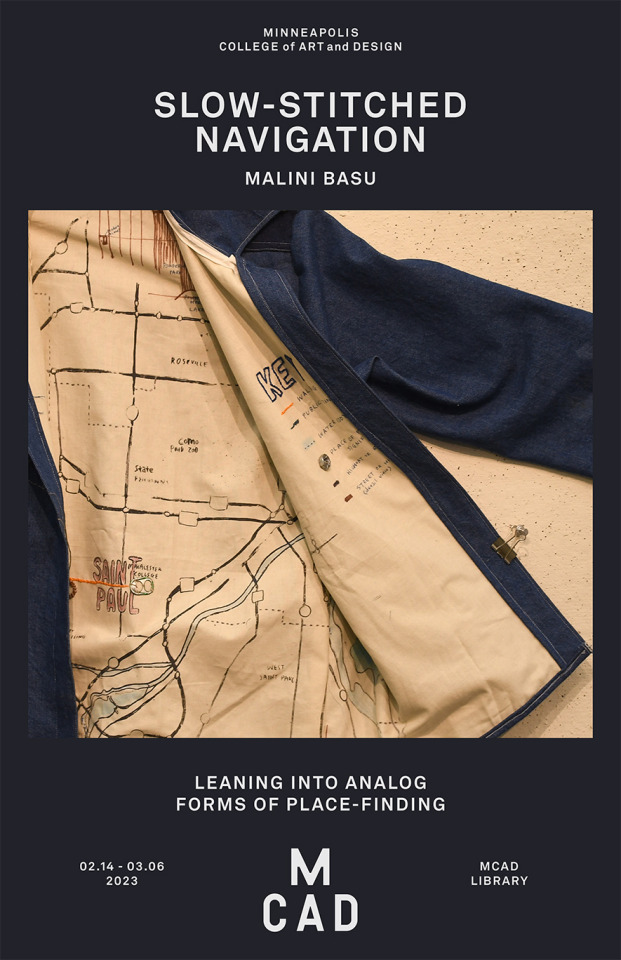
Slow-stitched Navigation
A Library Gallery exhibition by Malini Basu
We highly recommend making your way to see Malini Basu's exhibition: Slow-stitched Navigation, in the Library Gallery.
Exhibition:
Tuesday, February 14–Monday, March 6
Library Gallery @mcad
Introduction to the installation by Malini Basu:
I have never been good at directions—short walks that should be second nature to me could turn into hour-long meanders. When I moved from my home in India to the Twin Cities, I embraced the GPS system on my phone wholeheartedly, enjoying the ease with which I was able to navigate the public transit systems and the city at large. I followed the guiding blue line unquestioningly, trusting that I was being fed the most efficient path. Unsurprisingly, my mindless navigation did not assuage the disconnect I felt towards the cityscape I walked in and land I lived on.
In this body of work, I lean into slower modes of traversing the city. I focus on building an observational practice for myself, using objects found on the sidewalks as cues to look up and take note of my surroundings. I gradually build out my own mental map by tying the object to the surrounding intersection, the plants in season around me, the smells, the cracks in the sidewalks, my personal memories in that area. This practice led to tactile explorations of how I can connect my body to my movements through a place. While this project began as a response to navigating Minnesota, I was able to continue this mindful observation while in India this past winter. The works in this show thus reflect walks in both Minneapolis as well as Kolkata.
Recommended library books:
Wanderlust: Actions, Traces, Journeys, 1967-2017, by Rachel Adams, Rebecca Solnit, Lori Waxman, and Jane McFadden
The Map as Art: Contemporary Artists Explore Cartography, by Katharine A Harmon and Gayle Clemans
Walking and Mapping: Artists as Cartographers, by Karen O’Rourke
Walking Art Practice: Reflections on Socially Engaged Paths, by Ernesto Pujol
The Snowy Day, by Ezra Jack Keats
Fray: Art and Textile Politics, by Julia Bryan-Wilson
Drawing from Memory, by Allen Say (on order)
#maps#Minnesota#India#Kolkata#library gallery#mcad library gallery#library gallery @mcad#minneapolis college of art and design library#MCAD Library#mcad
9 notes
·
View notes
Video
Pl. 28: Tapisserie, par Henri Gillet [Tapestry. by Henri Gillet] by MCAD Library
Via Flickr:
Henri Gillet (French illustrator, 1880-1920) 1900 color lithograph 26.3 cm (height) x 36 cm (width) Scanned from: Album De La Décoration. Paris: Librairie des arts décoratifs See MCAD Library's catalog record for this book. intranet.mcad.edu/library
#MCAD#MCAD Library#MCAD Special Collection#A.Calavas#Album De La Décoration#Henri Gillet#color lithographs#Decoration and ornament#Birds in art#Peacocks in art#tapestries#Plants in art#Trees in art#Landscapes#Lithography#flickr#iris#iris flowers#brambles#roses#rosa#pinus
3 notes
·
View notes
Text
Chronic Illness Item Checklist
I'm just coming off of a flare-up of everything all at once (MCAS, EDS, POTS, bunch of other shit), so here's a checklist of items I keep in my room at all times. Applicable for a lot of illnesses. Not my usual content, but important stuff.
Tums
Pepto Bismol
Nausea candies (preggie pops are pretty good, though they're meant for pregnant people. They work for anyone with nausea though)
bowl just in case
blankets
pillows to keep you propped up
gloves for cold hands/poor circulation
a fan for hot flashes
phone charger and earbuds in convenient distance
Gatorade/Liquid IV/Powerade/ hydrator of your choice
Tissues
2 LABELED chapsticks. One for your lips and one for your nostrils (excessive sneezing or running of the nose causes chapped skin around nostrils).
Trash can.
Painkiller for joints and/or headaches. Make sure you're taking as advised and check any interactions with other medications.
Cool washcloth
If you have one, an alexa to ask to turn the lights on and off. I don't have one but it would be nice.
Mobility aid in distance if you use or need one.
Fellow POTS folks, KEEP PILLOWS IN REACH. If you feel like you're about to faint, hedge your bets and try to land on a pillow instead of just the ground.
Keep your phone charged up in case you need to call for help.
6 notes
·
View notes
Text
I need my cromolyn dose increased, I've been on the pediatric dose for a long time but my symptoms have gotten worse and I'm an adult now so I reaallllyyy need to increase it (especially before I start having anaphylaxis again)
I started off at a low dose to see if it would help and it did! it almost cured me at the time but it's been 3, almost 4 years and my symptoms are progressively getting worse
#chronic illness#chronically ill#mast cell activation syndrome#mast cell activation disorder#MCAS#MCAD
8 notes
·
View notes
Text
mast cells united: a summary of my thoughts
overall, I do not like the author. her scientific communication is very weak, her perseverance on naturopathy ranges from grating to outright concerning, and between the two it drastically weakens the overall quality of this book as a resource. there's also some deeply problematic discussion of autism sprinkled in at random. and no glossary at all which seems like a very strange thing to leave out, especially as terms get defined sporadically in the main body (and more often than not, either repeatedly or not at all). the perseverance on naturopathy in particular never seemed to be mentioned when I heard others talking about it, and it was downplayed in the cover blurb as well, so do be aware of that.
however, there are still chunks of this book that are more helpful than the information presented in never bet against occam, the other Big Book Of MCAS. these two books are likely to be most useful in conjunction with one another, with a strong eye for editorializing this one in particular, much like one is strongly suggested to skip certain episodes of classic TV series for the optimal viewing experience.
I would advise reading never bet against occam first, as it rests largely on a number of case studies that are presented in a manner making it much easier to recognize potential symptoms of mcas and bring it to the table for initial consideration. mast cells united is much less narrative in its presentation of potential symptoms aside from the author's experience described in chapter 1 which is gonna be of highly limited recognition especially as the only one, but provides a greater quantity of condensed and accessible information about things like the mast cell itself and supported treatments that is also several years more up to date than occam, making it less useful for raising initial suspicions but more useful as an information resource in the process of diagnosis and treatment.
when reading mast cells united, I strongly advise skipping the following entirely:
chapter 1
in chapter 4, the section starting with the header "MCAS and the RCCX theory" up until the header "the tryptase conundrum"
chapter 5
in chapter 6, the section starting with the header "the big picture approach" through the end of the chapter
in chapter 7, the section starting with the header "autism spectrum disorders" through the end of the chapter
chapter 8
in chapter 9, the section starting at the beginning of the chapter up until the header "mainstream medications for mcas treatment"
chapter 10 (although the section on pregnancy may have some value)
in chapter 12, the section starting with the header "detoxification" up until the header "exercise and MCAS" - the section starting with the header "neuropsychological treatment approaches" up until the header "strategies for emotional healing" - the section starting with the header "joy vs happiness" up until the header "other strategies to restore [PSNS] dominance"
I did not read chapter 11 for personal reasons but it may be useful to others if approached with due caution.
there are other small sections that irritated or bored me, including elements of ableism and patronization, but this removes the majority of the Complete Trash from the pile, leaving you with mostly beneficial information, which will make it an overall more pleasant and useful experience. there are some sections that include discussion of medical neglect, which I have for the most part left in, for though it can be upsetting it is useful.
the author's resource website is still up under the same name as the book, and it looks like she put out another book in 2021 that is much more explicit in the description about its focus on naturopathy, so I'm gonna just assume that of the two probably just get this one, unless you're into it too. and don't worry, of course she also offers a $300 video course about mold! :|
for more detailed (less organized) thoughts, see my other posts as I read under the tag [mast cells united].
#mast cells united#amber walker#mast cells united: a holistic approach to mast cell activation syndrome#mcas#mcad#mast cell activation syndrome#mastocytosis#trying to make this findable :T#long post
2 notes
·
View notes
Text
i'm having to downplay my issues to get doctors to even speak to me this is bullshit
usually it's "you're not disabled enough" that keeps people from getting diagnosed, apparently i'm too fucked up to even be seen
#what the fuck#this is bullshit#cripplepunk#cripple punk#spoonie#chronically ill#chronic pain#allergies#food allergies#mcas#mast cell diseases#mcad#mast cell activation syndrome#mast cell activation disorder#eds#hypermobility#hypermobile#hypermobile eds#heds#orthostatic hypotension#fibromyalgia#fibro#ableism
8 notes
·
View notes
Text
When I found out that the med I take makes me severely immunocompromised and no one warned me. During a pandemic...

37 notes
·
View notes
Note
Do you have examples of Dobson's college work? May have seen them at one point though.
There’s some. Thankfully someone archived his “Andy’s Artwork” website so you can see a lot of his older work.


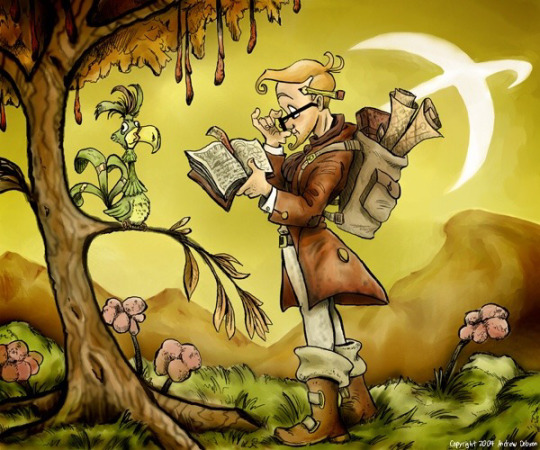
You can usually tell the difference between Dobson’s college art and his post college art because the college stuff has clear effort put in, something his teachers must have been pushing him to do because he resented doing so.
16 notes
·
View notes